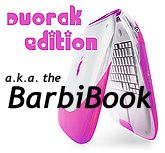Years ago, when desktops were beige and laptops were black, a
revolution was born. Apple beat the odds and introduced the iMac to the world, adding a
splash of color and innovation to the stale PC market.
And what's better than a multicolored, all-in-one, easy to use
computer? A notebook to match, the iBook.
 Available in iMac-matching blueberry
or orange, the first generation iBook did to the notebook market what
the iMac had done to the desktop market: It provided an affordable,
easy to use, and reliable machine for the consumer market that stood
out from the monotonous HP's and Dells.
Available in iMac-matching blueberry
or orange, the first generation iBook did to the notebook market what
the iMac had done to the desktop market: It provided an affordable,
easy to use, and reliable machine for the consumer market that stood
out from the monotonous HP's and Dells.
Marketed as "an iMac to go", the iBook shipped with a 300 MHz
PowerPC G3, 32 MB or 64 MB of onboard RAM, a 12" (800 x 600) active
matrix display, a 3 GB or 6 GB hard disk, and an optional
AirPort card. It had plenty of power to run Mac OS 8.6 or 9.x, but more
RAM is a must for OS X.
Fast forward to 2006, seven years after its debut. How useful is the
clamshell iBook in today's world?
I wanted to buy a notebook computer for my 14-year-old cousin from
Italy. Initially I thought a PC would be best, due to the lack of Apple
support in Italy, but as I watched her use my Mom's Pismo PowerBook and easily
navigate and enjoy the functionality, I decided that a Mac would be
perfect.
I found an excellent deal on
eBay: A blueberry 300 MHz machine with 128 MB of RAM, a 6 GB
hard drive, and and Airport card - all for $120.
I knew that OS X was a must, but the limited 6 GB hard drive
and 128 MB of RAM would be a real problem for 10.4, so I went with
10.3, which worked great after a mere 64 MB RAM upgrade. Applications
such as Office 2004 and iTunes are slow loaders, but once up and
running they perform in a satisfactory capacity. 3D games are,
obviously, not a good idea on this machine with just 4 MB of
VRAM.
The screen, although limiting with its 800 x 600 maximum resolution,
is crisp and bright. Expansion ports are lacking in this model, since
it has only one USB 1.1 port, ethernet, and a modem, but that adds to
the notion of simplicity that Apple clearly wanted to convey with this
machine.
The handle included on this machine is also a very nice touch and
was very convenient.
 Case design is a mixed bag, both
now and in 1999. Many touted the iBook as being too feminine (see
The BarbiBook), due to its
clamshell shape and colors.
Case design is a mixed bag, both
now and in 1999. Many touted the iBook as being too feminine (see
The BarbiBook), due to its
clamshell shape and colors.
It was only with the release of the Graphite Special Edition
that the iBook gained a more elegant feel. However, given its target
market being high school and college kids, the design was appropriate
and well marketed. Even today one of these original iBooks stands out
in a crowd - in a positive way.
Bringing this machine to the office or campus isn't something I
would do; however a for an Italian high school student, this machine is
perfect.
Granted, this iBook isn't a speed demon in any way, but it's amazing
what a 7-year-old Apple notebook can do. And what's more incredible is
that it still looks good doing it.

Further Reading
- Getting the most out of the clamshell
iBook, Charles Moore, Miscellaneous Ramblings, 2006.08.14.
"'Unique' is an overworked adjective, but in the case of the clamshell
iBook, it's justified. There's never been anything quite like it before
or since."

 Available in iMac-matching blueberry
or orange, the first generation iBook did to the notebook market what
the iMac had done to the desktop market: It provided an affordable,
easy to use, and reliable machine for the consumer market that stood
out from the monotonous HP's and Dells.
Available in iMac-matching blueberry
or orange, the first generation iBook did to the notebook market what
the iMac had done to the desktop market: It provided an affordable,
easy to use, and reliable machine for the consumer market that stood
out from the monotonous HP's and Dells. Case design is a mixed bag, both
now and in 1999. Many touted the iBook as being too feminine (see
Case design is a mixed bag, both
now and in 1999. Many touted the iBook as being too feminine (see

